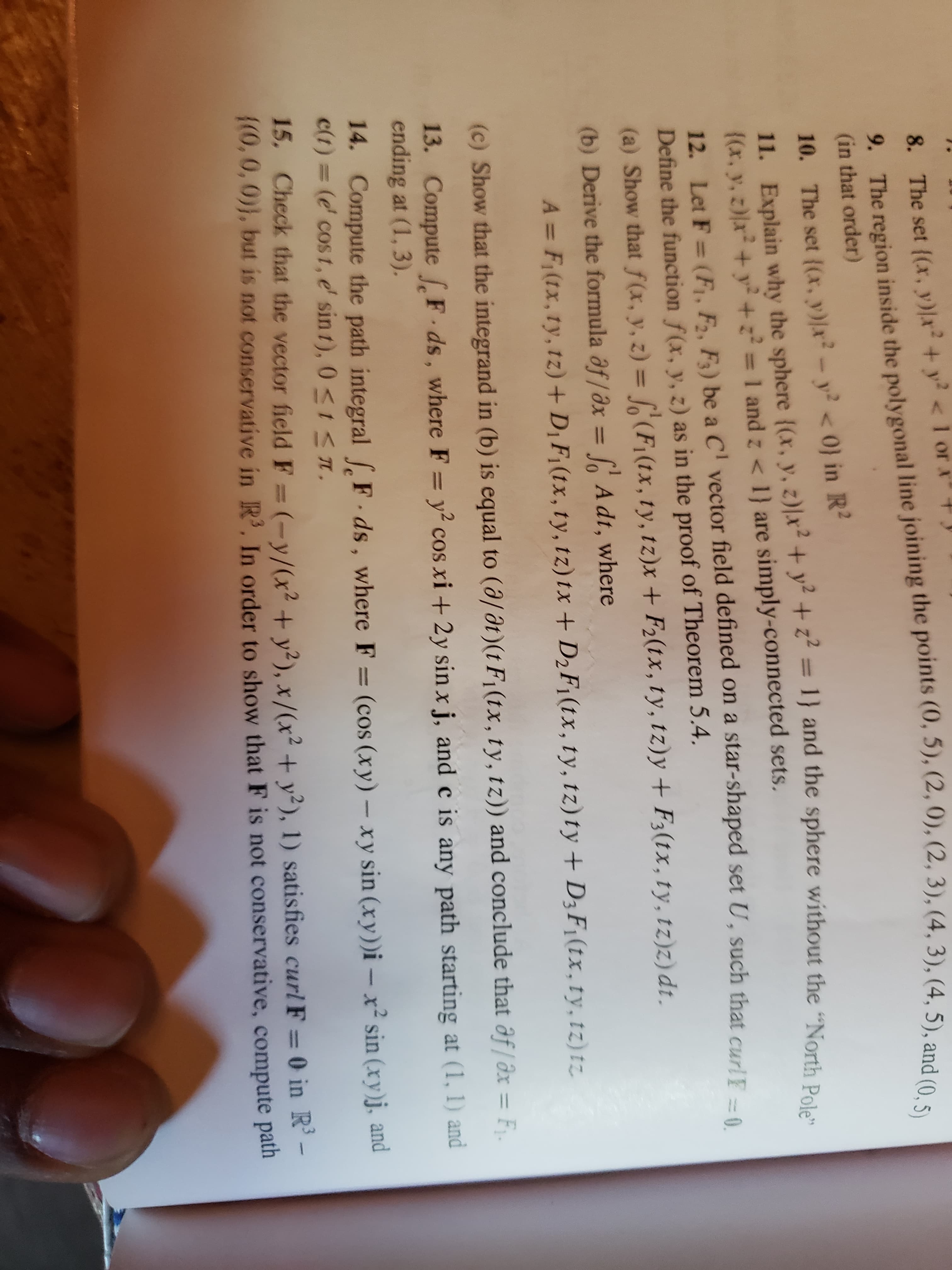8. The set ((x, y)x + y <1 or x+ 9. The region inside the polygonal line joining the points (0, 5), (2, 0), (2, 3), (4, 3), (4, 5), and (0, 5) (in that order) 10. The set ((x, y)|x² – y² < 0} in R? 11. Explain why the sphere {(x, y, z)|x² + y´ + z" = 1} and the sphere without the “North Date ((x, y, 2)x+ y+z =1 and z < 1} are simply-connected sets. 12. Let F = (F, F, F) be a C' vector field defined on a star-shaped set U, such that curlE-o Define the function f(x, y, z) as in the proof of Theorem 5.4. (a) Show that f(x, y, z) = f, (F;(tx,ty, tz)x + F2(tx,ty, tz)y + F3(tx,ty,tz)z)dt. %3D %3D %3D (b) Derive the formula ôf/ax So A dt, where %3D A = F;(tx,ty,1z) + D¡F;(tx,ty, tz)tx + D2F1(tx,ty,tz)ty+ D3F¡(tx,ty,tz)1z (c) Show that the integrand in (b) is equal to (a/at)(t F1(tx, ty, tz)) and conclude that af/ôx = F1. %3D 13. Compute F ds, where F = y² cos xi + 2y sin x j, and c is any path starting at (1, 1) and ending at (1, 3). 14. Compute the path integral (F•ds, where F = (cos (xy) – xy sin (xy))i– x² sin (xy)j, and c(t) = (e' cos 1, e' sin t), 0
8. The set ((x, y)x + y <1 or x+ 9. The region inside the polygonal line joining the points (0, 5), (2, 0), (2, 3), (4, 3), (4, 5), and (0, 5) (in that order) 10. The set ((x, y)|x² – y² < 0} in R? 11. Explain why the sphere {(x, y, z)|x² + y´ + z" = 1} and the sphere without the “North Date ((x, y, 2)x+ y+z =1 and z < 1} are simply-connected sets. 12. Let F = (F, F, F) be a C' vector field defined on a star-shaped set U, such that curlE-o Define the function f(x, y, z) as in the proof of Theorem 5.4. (a) Show that f(x, y, z) = f, (F;(tx,ty, tz)x + F2(tx,ty, tz)y + F3(tx,ty,tz)z)dt. %3D %3D %3D (b) Derive the formula ôf/ax So A dt, where %3D A = F;(tx,ty,1z) + D¡F;(tx,ty, tz)tx + D2F1(tx,ty,tz)ty+ D3F¡(tx,ty,tz)1z (c) Show that the integrand in (b) is equal to (a/at)(t F1(tx, ty, tz)) and conclude that af/ôx = F1. %3D 13. Compute F ds, where F = y² cos xi + 2y sin x j, and c is any path starting at (1, 1) and ending at (1, 3). 14. Compute the path integral (F•ds, where F = (cos (xy) – xy sin (xy))i– x² sin (xy)j, and c(t) = (e' cos 1, e' sin t), 0
Linear Algebra: A Modern Introduction
4th Edition
ISBN:9781285463247
Author:David Poole
Publisher:David Poole
Chapter4: Eigenvalues And Eigenvectors
Section4.2: Determinants
Problem 13AEXP
Related questions
Topic Video
Question
100%
Can you help with 13 please?

Transcribed Image Text:8. The set ((x, y)x + y <1 or x+
9. The region inside the polygonal line joining the points (0, 5), (2, 0), (2, 3), (4, 3), (4, 5), and (0, 5)
(in that order)
10. The set ((x, y)|x² – y² < 0} in R?
11. Explain why the sphere {(x, y, z)|x² + y´ + z" = 1} and the sphere without the “North Date
((x, y, 2)x+ y+z =1 and z < 1} are simply-connected sets.
12. Let F = (F, F, F) be a C' vector field defined on a star-shaped set U, such that curlE-o
Define the function f(x, y, z) as in the proof of Theorem 5.4.
(a) Show that f(x, y, z) = f, (F;(tx,ty, tz)x + F2(tx,ty, tz)y + F3(tx,ty,tz)z)dt.
%3D
%3D
%3D
(b) Derive the formula ôf/ax
So A dt, where
%3D
A = F;(tx,ty,1z) + D¡F;(tx,ty, tz)tx + D2F1(tx,ty,tz)ty+ D3F¡(tx,ty,tz)1z
(c) Show that the integrand in (b) is equal to (a/at)(t F1(tx, ty, tz)) and conclude that af/ôx = F1.
%3D
13. Compute F ds, where F = y² cos xi + 2y sin x j, and c is any path starting at (1, 1) and
ending at (1, 3).
14. Compute the path integral (F•ds, where F = (cos (xy) – xy sin (xy))i– x² sin (xy)j, and
c(t) = (e' cos 1, e' sin t), 0 <IST,
%3D
15, Check that the vector field F = (-y/(x² + y²), x /(x² + y²), 1) satisfies curl F = 0 in R’-
(0,0,0)), but is not conservative in R'. In order to show that F is not conservative, compute path
%3D
%3D
Expert Solution
This question has been solved!
Explore an expertly crafted, step-by-step solution for a thorough understanding of key concepts.
This is a popular solution!
Trending now
This is a popular solution!
Step by step
Solved in 4 steps with 4 images

Knowledge Booster
Learn more about
Need a deep-dive on the concept behind this application? Look no further. Learn more about this topic, advanced-math and related others by exploring similar questions and additional content below.Recommended textbooks for you

Linear Algebra: A Modern Introduction
Algebra
ISBN:
9781285463247
Author:
David Poole
Publisher:
Cengage Learning

Algebra & Trigonometry with Analytic Geometry
Algebra
ISBN:
9781133382119
Author:
Swokowski
Publisher:
Cengage

Elementary Geometry For College Students, 7e
Geometry
ISBN:
9781337614085
Author:
Alexander, Daniel C.; Koeberlein, Geralyn M.
Publisher:
Cengage,

Linear Algebra: A Modern Introduction
Algebra
ISBN:
9781285463247
Author:
David Poole
Publisher:
Cengage Learning

Algebra & Trigonometry with Analytic Geometry
Algebra
ISBN:
9781133382119
Author:
Swokowski
Publisher:
Cengage

Elementary Geometry For College Students, 7e
Geometry
ISBN:
9781337614085
Author:
Alexander, Daniel C.; Koeberlein, Geralyn M.
Publisher:
Cengage,